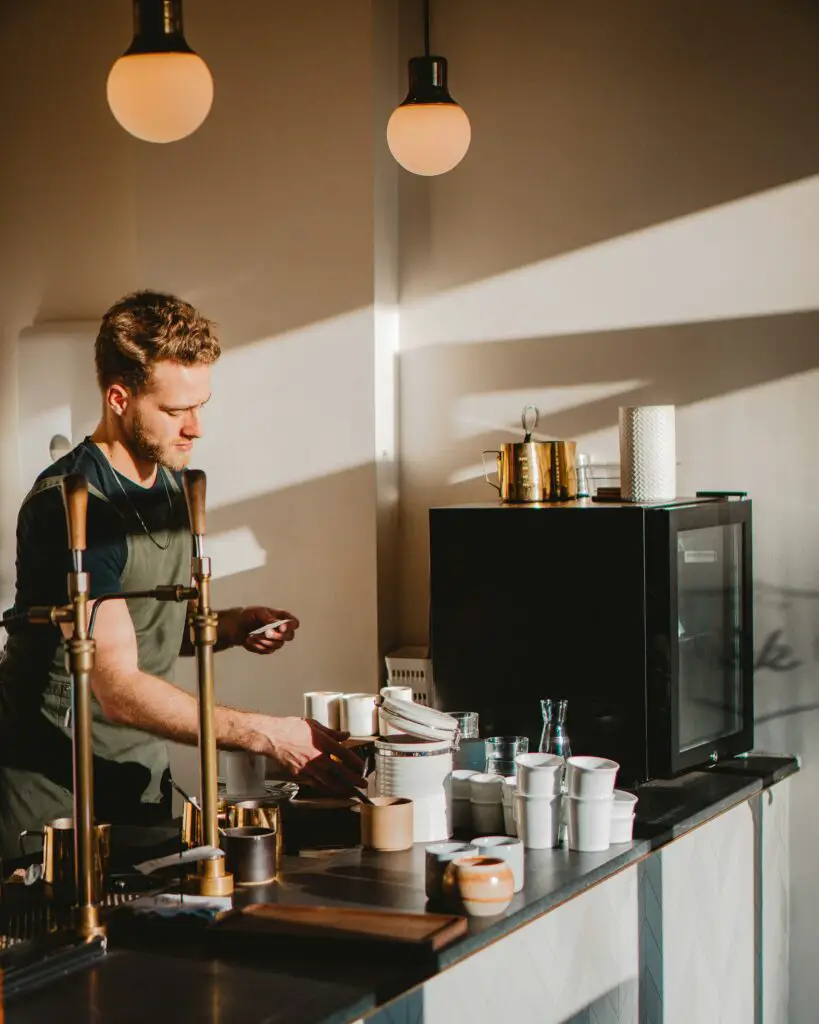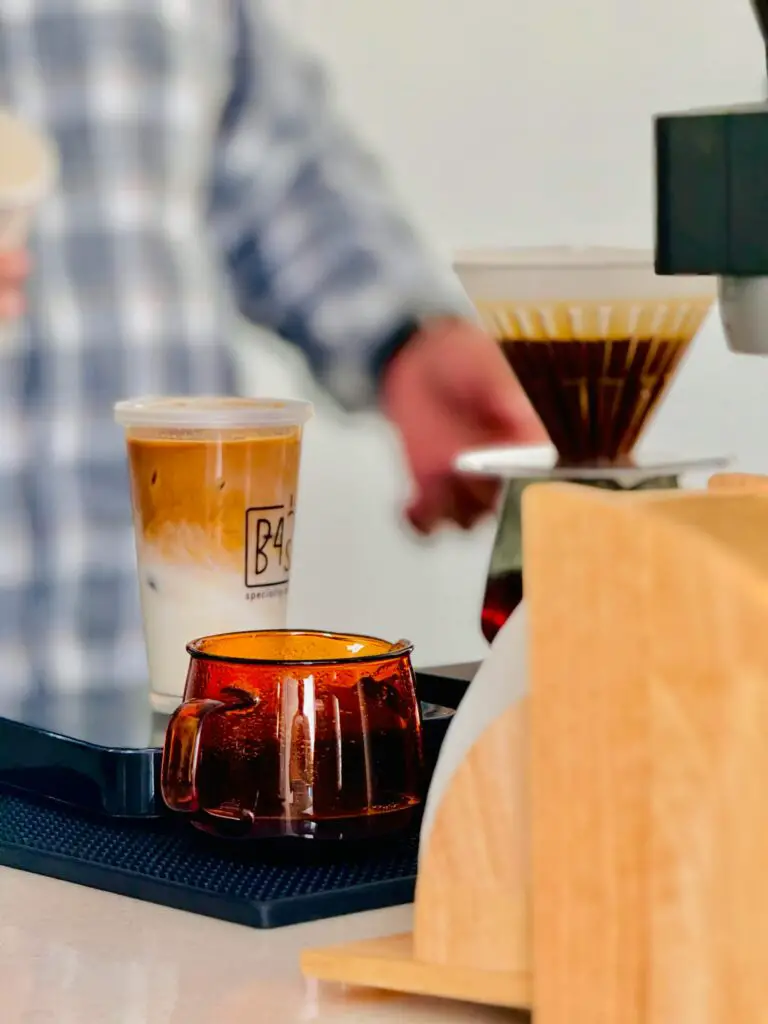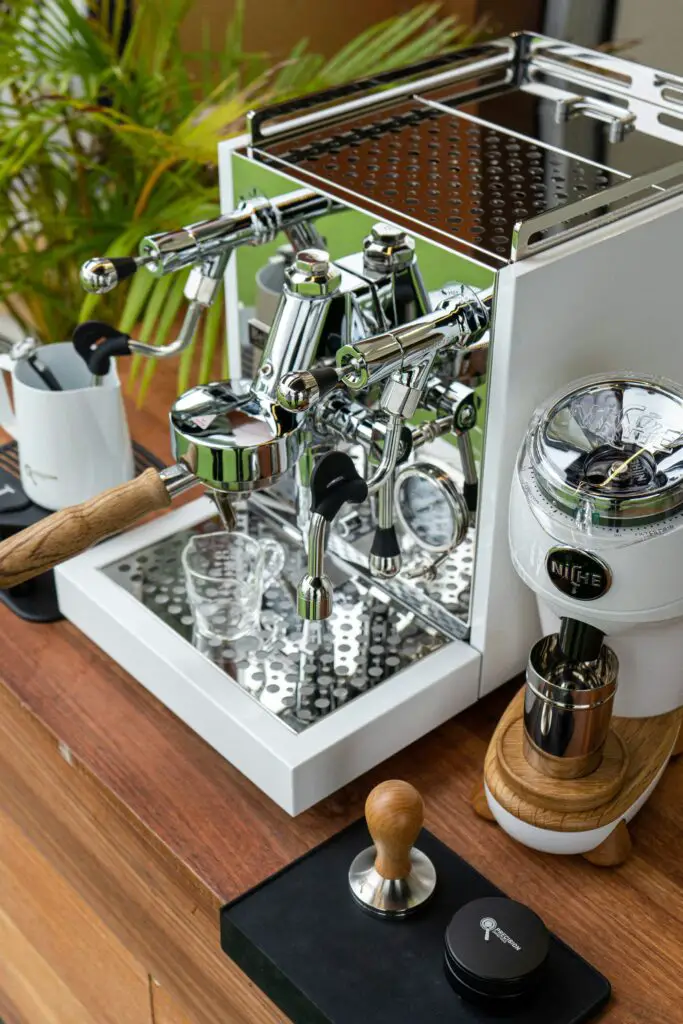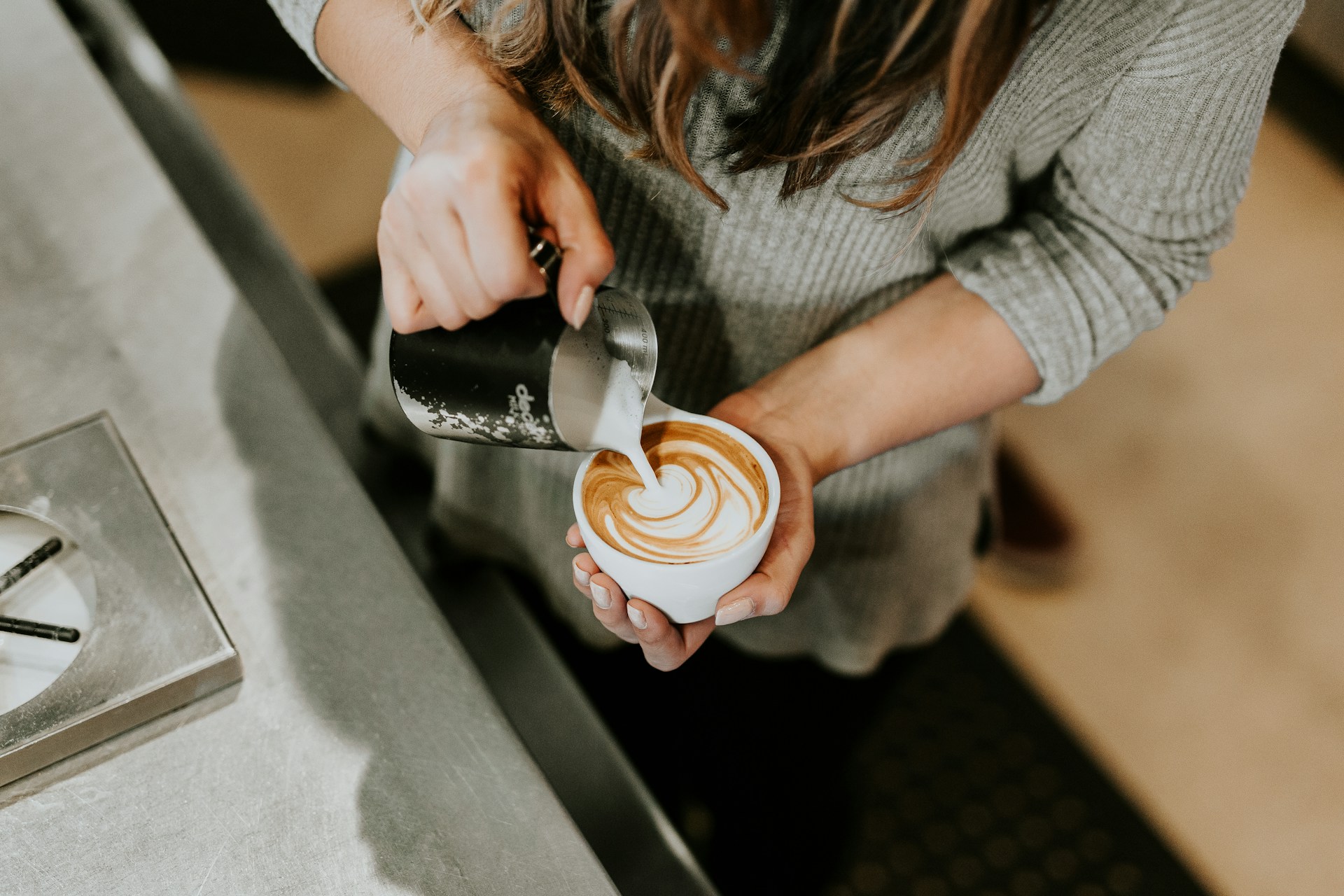Becoming a barista is more than just making coffee; it’s an art that requires skill and passion.
Baristas are crucial in the coffee industry.
They not only prepare your favorite brews but also enhance your coffee experience with their knowledge and customer service.
This post will guide you through 10 essential steps to embark on this fulfilling career.

10 Steps To Become A Barista: An Overview
- Step 1: Understand the Role
- Step 2: Learn About Coffee
- Step 3: Get the Right Training
- Step 4: Master the Equipment
- Step 5: Practice Making Espresso
- Step 6: Learn Milk Steaming and Latte Art
- Step 7: Explore Different Coffee Drinks
- Step 8: Develop Customer Service Skills
- Step 9: Gain Experience
- Step 10: Stay Updated and Continue Learning
Now, let’s go over each of these steps in more detail!
Step 1: Understand the Role

What is a Barista?
A barista is a professional who specializes in making and serving coffee-based beverages, particularly espresso-based drinks such as lattes, cappuccinos, and espresso shots.
They operate coffee machines and use various brewing methods to deliver delicious drinks.
The term “barista” originates from Italian, where it means a bartender who serves hot drinks, cold beverages, and snacks.
Key Responsibilities
- Preparing Coffee: Baristas must know how to use different coffee machines and techniques.
- Customer Service: They interact directly with customers, take orders, and sometimes handle payments.
- Maintenance: Keeping the coffee station clean and the equipment in good working order is crucial.
- Product Knowledge: A good barista understands the types of coffee they serve, including where the beans come from and how they impact flavor.
Required Skills
- Attention to Detail: Every step in making coffee can affect the taste.
- Communication: Clear communication with customers and coworkers is essential.
- Patience and Efficiency: Balancing speed with quality service during busy times is key.
- Passion for Coffee: Loving the product you make improves performance and customer interaction.
Step 2: Learn About Coffee

Types of Coffee Beans
Coffee beans are mainly categorized into two types: Arabica and Robusta.
There are other types of coffee beans but these are the two main types of coffee beans most coffee shops and cafes use daily and are typically the most common.
Understanding these types will help you explain the flavors to customers and make better brewing choices.
- Arabica: Known for its sweet, soft taste and higher acidity, Arabica beans are popular in specialty coffee shops.
- Robusta: These beans have a stronger, harsher taste compared to Arabica and contain more caffeine.
Coffee Growing Regions
The flavor of coffee beans is heavily influenced by where they are grown.
- Latin America: Beans from this region often have crisp acidity and are slightly sweet, perfect for light roasts.
- Africa: African beans are famous for their fruity and floral flavors, making them great for those who enjoy complex tastes.
- Asia: Typically, Asian coffee is bold and robust, often with earthy or woody notes.
To learn more about the different coffee regions around the world and their flavor profiles, check out this article.
Step 3: Get the Right Training

Types of Barista Training Programs
Training is crucial for a barista because it enhances their skills, knowledge, and confidence, ultimately leading to better customer satisfaction and a more successful business.
Here are some key reasons why training is important for a barista:
- Building Confidence: A well-trained barista is more likely to be confident in their abilities, which translates to faster service, less waste, and better-tasting drinks.
- Efficiency: Trained baristas are more efficient in their work, allowing them to handle busy periods and high volumes of customers effectively.
- Consistency: Barista training ensures that production standards are met, and the results are uniform, which is essential for maintaining a consistent brand image and customer experience.
- Knowledge Sharing: A trained barista can share information about the coffee products with customers, enhancing the overall customer experience and increasing customer loyalty.
- Team Building: Barista training fosters a sense of teamwork and encourages baristas to learn from each other, leading to a more cohesive and supportive work environment.
- Reducing Turnover: Regular training can help reduce turnover rates among baristas, as they feel more engaged and motivated in their roles.
- Enhancing Brand Reputation: A well-trained barista represents the brand positively, which can lead to increased customer loyalty and a stronger brand reputation.
- Building Responsibility: Barista training builds responsibility, trust, and efficiency among baristas, leading to a greater sense of ownership and accountability.
- Avoiding Mistakes: Training helps baristas avoid costly mistakes, such as over- or under-extracting coffee, which can lead to significant losses for the business.
There are several types of programs available:
- Workshops: Short sessions that cover basics like espresso making and milk frothing.
- Certification Courses: These are more comprehensive and often required by specialty coffee shops.
- On-the-Job Training: Many coffee shops provide hands-on training to new hires.
Recommended Barista Schools or Online Courses
Choosing the right place to learn can make a big difference:
- Barista Hustle: Great for online certifications that focus on different aspects of coffee making.
- Specialty Coffee Association (SCA): Offers extensive courses and certifications, recognized worldwide.
- Local Coffee Shops: Many have training programs that are practical and tailored to their menu and service style.
Step 4: Master the Equipment

Overview of Essential Barista Equipment
To make great coffee, you need the right tools.
Here are the essentials:
- Espresso Machines: The centerpiece of any coffee shop, used for extracting espresso.
- Grinders: These are crucial for getting the right grind size for your coffee beans, which affects the taste.
- Tampers: Used to press the coffee grounds evenly in the espresso machine’s basket.
- Milk Frothers: For making creamy froth for lattes and cappuccinos.
Knowing how to use these tools effectively is key to making top-notch coffee.
Tips for Using and Maintaining Equipment
Proper use and care of your equipment ensure consistently good coffee and longer-lasting machines.
- Regular Cleaning: Clean your espresso machine and grinder daily to prevent oil build-up and ensure fresh flavors.
- Correct Usage: Learn the specific settings and functions of your equipment. Each model may be different.
- Maintenance Checks: Regularly check for wear and tear. Replace parts like seals and filters as needed.
Step 5: Practice Making Espresso

The Process of Making the Perfect Espresso
Making a great espresso is an art that requires practice.
Most specialty drinks like lattes and cappuccinos use espresso as the base for the drink, so learning how to extract a great espresso shot is essential.
Here’s how to do it:
- Measure the Coffee: Use about 18 grams of coffee for a standard shot.
- Grind the Coffee: Aim for a fine, consistent grind.
- Tamp the Coffee: Press the coffee grounds evenly to ensure uniform extraction.
- Brew: Run hot water through the coffee grounds for about 25-30 seconds.
Consistency is key and remember that every step affects the flavor.
Common Mistakes and How to Avoid Them
Mistakes are common when learning to make espresso.
Here are a few to watch out for:
- Inconsistent Coffee Measurement: Always use a scale to measure your coffee.
- Incorrect Grind Size: If your espresso is too fast or slow, adjust your grind size.
- Uneven Tamping: Practice tamping with even pressure to avoid channeling, where water passes through the coffee unevenly.
- Ignoring Machine Temperature: Make sure your espresso machine is properly heated before brewing.
Step 6: Learn Milk Steaming and Latte Art

Techniques for Steaming Milk
Steaming milk correctly is essential for creating creamy lattes and cappuccinos.
The process of steaming milk involves heating the milk to a specific temperature and incorporating air into it, which creates a creamy texture and a velvety consistency.
This texture is essential for achieving the desired mouthfeel and overall taste in coffee beverages like lattes, cappuccinos, and macchiatos.
Here’s how to do it:
- Start with Cold Milk: Use fresh, cold milk for the best froth.
- Use the Right Pitcher: A stainless steel pitcher works best for steaming.
- Position the Steam Wand: Submerge the tip just below the milk’s surface to create a whirlpool effect.
- Heat to the Right Temperature: Aim for about 150-155°F. Overheating can make the milk taste burnt.
Smooth, velvety milk is the goal.
It makes a big difference in the texture and taste of your drinks.
Basics of Creating Latte Art
Latte art adds a creative touch to your beverages.
Latte art refers to the skill of creating designs or patterns on the surface of a latte, which is a coffee drink made with espresso and steamed milk.
The art is made by pouring steamed milk into a shot of espresso in a way that allows the barista to manipulate the milk as it mixes with the coffee to form decorative patterns.
It is a technique that combines the culinary and visual arts, showcasing the barista’s skill in creating aesthetically pleasing and often intricate designs.
The process of creating latte art involves two main techniques: free pouring and etching.
Free pouring is the more technical of the two, where the milk is poured directly from a jug into the espresso, with the barista using wrist and hand movements to shape the milk flow into patterns such as hearts, rosettas, or more complex designs like swans and wave tulips.
Etching involves drawing on the coffee with a thin tool, like a toothpick, to create detailed images or even 3D art.
Latte art has become a symbol of the care and attention paid to the coffee-making process, offering a moment of beauty and connection between the barista and the coffee drinker.
It has grown in popularity alongside the rise of coffee culture, particularly since the 1980s, and today there are even competitions where baristas showcase their latte art skills.
Here are the basics to get started:
- Perfect Your Milk Foam: It should be smooth and silky, without large bubbles.
- Pour Steadily: Begin pouring the milk from high above the cup, then bring the pitcher closer as the cup fills.
- Create a Pattern: Start with simple designs like a heart or a rosetta. Move the pitcher through the milk to shape your design.
Latte art requires patience and practice.
Don’t get discouraged if it doesn’t work at first. Keep practicing, and you’ll improve over time.
Step 7: Explore Different Coffee Drinks

Recipes and Preparation Methods for Popular Coffee Drinks
Knowing how to make a variety of coffee drinks is essential for any barista.
It allows baristas to cater to the diverse tastes and preferences of customers.
By being familiar with different coffee drinks and their preparation methods, baristas can offer a wider range of options to customers, increasing customer satisfaction and loyalty.
This is particularly important in today’s competitive coffee shop market where customers have numerous choices and are often looking for unique experiences.
Here are a few classics:
- Espresso: The base for many drinks, made by forcing hot water through finely-ground coffee.
- Americano: Mix one part espresso with two parts hot water.
- Cappuccino: Prepare with equal parts espresso, steamed milk, and frothed milk.
- Latte: Use one part espresso with three parts steamed milk, topped with a small amount of froth.
Practice these staples until you can make them with consistency and confidence.
How to Customize Drinks to Customer Preferences
Customization is key to satisfying your customers.
When a barista can confidently prepare a variety of coffee drinks, they are better equipped to handle customer requests and preferences, ensuring that each customer receives their desired beverage.
This not only improves customer satisfaction but also boosts the barista’s confidence and efficiency in their work.
Here’s how you can tailor drinks:
- Ask About Preferences: Some people prefer drinks less sweet or with non-dairy milk.
- Offer Variety: Keep a range of syrups and milk alternatives available.
- Learn Common Modifications: Be ready to make drinks lighter, stronger, or less sweet based on common requests.
Step 8: Develop Customer Service Skills

Importance of Customer Service in a Barista’s Role
Good customer service is as important as making great coffee.
It helps create a welcoming atmosphere and keeps customers coming back.
Excellent service turns casual visitors into loyal patrons.
- Engagement: A friendly greeting and a smile can make all the difference.
- Efficiency: Quick, accurate service shows respect for customers’ time.
- Attention: Listening to customers’ orders and preferences helps ensure they leave satisfied.
Tips for Enhancing Customer Interaction and Satisfaction
Here’s how you can improve your interactions with customers:
- Learn Names: Try to remember the names and usual orders of regulars.
- Stay Positive: Maintain a cheerful demeanor, even under pressure.
- Handle Complaints Gracefully: Address any issues promptly and with a calm, helpful attitude.
- Go the Extra Mile: Small gestures, like offering a water refill or giving advice on coffee selection, can make a big impact.
Step 9: Gain Experience

Getting hands-on experience is crucial to becoming a proficient barista.
Experience can come from various sources such as working in a coffee shop, attending barista training courses, or participating in workshops and seminars focused on coffee-making techniques.
Through these experiences, baristas can learn how to operate espresso machines, grind coffee beans, and froth milk to the desired consistency, which are all essential skills for creating high-quality coffee drinks.
Moreover, hands-on experience provides baristas with the opportunity to practice their skills under real-world conditions, which is critical for developing muscle memory and improving their overall efficiency.
This hands-on approach also allows baristas to learn from their mistakes, adapt to different situations, and develop problem-solving skills, all of which are vital for success in the fast-paced environment of a coffee shop.
Here’s how you can start:
- Internships: Look for internship opportunities at local coffee shops. These can provide valuable insights and real-world skills.
- Part-time Jobs: Working part-time as a barista is one of the best ways to learn. You’ll handle different machines and interact with a variety of customers.
- Volunteering: Events and community gatherings often need people to serve coffee. Volunteering your services can be a great way to practice.
Step 10: Stay Updated and Continue Learning

Keeping Up with Industry Trends and New Coffee-Making Techniques
The coffee industry is always evolving.
The coffee industry is driven by shifting consumer preferences, technological advancements, and innovations in production and distribution.
In recent years, the coffee industry has grown a lot.
This boom is thanks to more people loving specialty coffee, a growing interest in eco-friendly products, and the spread of coffee culture through coffee shops, cafes, and home brewing.
Newcomers like small-batch roasters, artisanal coffee shops, and online stores have shaken up old business ways, bringing fresh ideas and chances for innovation and entrepreneurship.
Staying current is crucial, and here are some of the easiest ways to do so:
- Follow Industry News: Subscribe to coffee industry publications and blogs.
- Attend Workshops and Seminars: These can be great places to learn about new techniques and trends.
- Participate in Barista Competitions: Competitions not only challenge your skills but also expose you to innovative practices.
Resources for Ongoing Learning and Professional Development
Continuous learning is key to advancing in your career.
Here are some resources:
- Online Courses: Websites like Udemy and Coursera offer courses on everything from coffee basics to advanced barista skills.
- Books and Magazines: Read books and trade magazines that focus on coffee and barista techniques.
- Social Media Groups: Join groups and forums where professionals discuss their experiences and share advice.
Conclusion
Becoming a barista involves several important steps, from understanding the role and learning about coffee to mastering equipment and enhancing customer service skills.
Each step builds on the last, preparing you for a successful career in coffee.
Whether you’re starting with learning espresso basics or perfecting latte art, the journey is rewarding.
Dive in, keep learning, and soon, you’ll craft not just great coffee but also memorable experiences for your customers.
If you’re passionate about coffee, embarking on a barista career could be a fulfilling path for you.
FAQ’s
What qualifications do you need to be a barista?
No formal qualifications are required to become a barista.
However, having training in coffee preparation and customer service can be beneficial.
Employers often value practical experience and a passion for coffee.
How does a beginner become a barista?
Beginners can start by learning about coffee and practicing basic brewing techniques at home.
Seeking out barista training courses or workshops and applying for entry-level positions in coffee shops are also good steps.
How long does it take to learn to be a barista?
The basics of being a barista can be learned in a few weeks with intensive training, but mastering the art of coffee making takes continuous practice and experience.
Most baristas feel confident after about 1-3 months on the job.
Are barista courses worth it?
Yes, barista courses are worthwhile as they provide structured learning, practical skills, and a deeper understanding of coffee.
They can also enhance your resume and help you stand out in job applications.
What age do I need to be to become a barista?
The minimum age to work as a barista can vary by location but typically ranges from 16 to 18 years old, depending on local labor laws and the employer’s policy.
How difficult is it to be a barista?
Being a barista can be challenging, especially in busy environments.
It requires multitasking, good memory for orders, and customer service skills.
However, it can also be very rewarding and fun for those who enjoy interacting with people and have a passion for coffee.
Is barista a skilled job?
Yes, being a barista is considered a skilled job.
It involves specialized knowledge of coffee, as well as technical skills in operating coffee machines and making various drinks to a high standard.
Do you have to drink coffee to be a barista?
No, you do not have to drink coffee to be a barista, but having a good understanding of different coffee tastes and strengths can enhance your ability to serve customers effectively and make recommendations.


